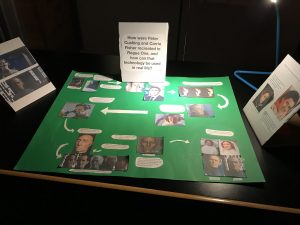As the end of 2017 approaches, and the second term starts, PLP had its annual winter exhibition. This year, the theme for the Grade 8s and 9s was Star Wars. Our projects ranged from topics about production to small details in the movies.
When you entered the building, you could enter the PLP room or the library. The PLP room was chock full of projects that had to do with the Light Side of the Force. They had costumes and props, and did skits every twenty minutes based on Star Wars. However, if you went into the library, you would enter the Dark Side of the Force.
When you stepped into the Dark Side, the first thing you would see is that the lights were off. The next thing you would notice would be the Cantina Bar, surrounded with lights that illuminated its sign. The Cantina Bar served red Gatorade, or ‘Vader-ade’, Jello, Tie-Fighter Cookies, and popsicles. Across from the Cantina Bar were all of the projects that related to how subjects from Star Wars would affect today’s world. This section was separated from those behind it with black paper. Directly behind the Cantina Bar, was the entrance to the space with every project about the philosophy of Star Wars. This section connected to a hallway of black paper, which led to every project about the Dark Side’s military. Beyond the Military section was the very back of the library, the section with every project about the creation of the movies.
In this section there were several projects around the room, with a giant green screen in the middle. There was an Ipad set up on a table that had a background for the green screen- an Imperial Starship deck. One of the projects in this section was mine.
My project was based on the question, ‘How were Peter Cushing and Carrie Fisher recreated in Rogue One, and how can that technology be used in real life?’ In Rogue One, which was the most recent Star Wars movie at the time of this project, multiple characters were recreated from the original, which takes place at the same time. In the main part of my project, I went step-by-step through the whole process.
The first step was to find stand-in actors, who could play the indisposed actors playing the characters. They found Guy Henry for Peter Cushing, and Ingvild Deila for Carrie Fisher. There were several steps based around scanning their facial movements, and placing them onto the other actor’s face. First, their faces were scanned at a light stage in Burbank, California, USA, that shined lights on their faces from every angle. Their faces were scanned while they sat in the light stage.The second step of tracking facial movements took place during filming. The stand-in actors had motion sensors all over their faces, while they filmed.The third step of facial movement tracking was a camera that fit around their heads and only filmed their faces.
- Ingvild Deila
- Guy Henry
- Ingvild Deila in costume with motion sensors.
- Guy Henry in costume with the motion sensors
- Guy Henry during filming with head camera
After filming was completed, the computer graphics were added. The animators had plenty of footage of Carrie Fisher from the original Star Wars trilogy to base her character off of, but Peter Cushing only had four minutes of screen time in the first Star Wars movie! However, the animators found a plaster cast of his face from the 1984 movie Top Secret. This was scanned and placed on the model of Guy Henry’s face, and tweaked until it looked realistic.
Creating this project took a long time, a lot of effort, and a lot of revision. I learned quite a few things about critique, revision, and presenting. Critique is very helpful, and helps your project improve. Also, revision is always useful, even if your project could be complete. For presentation, sometimes it helps to be able to change your presentation based on the audience’s level of understanding about the subject. If kids didn’t know much about CGI, I would explain it as animation, and that the other actors’ faces were animated over the stand-in actors. If someone knew a lot about Star Wars, it was evident and I could skip the intro where I explain exactly what Rogue One is and how it relates to the rest of Star Wars.
I think that the revision process I’ve learned during this exhibition will change how I do projects in the future. Exhibitions are a great way to understand how projects and presentations work. It was a great experience and I hope I can have the same positive experience next time.











The words you used to describe the process of the project were very informative
The photos could be centred or right or left justified to add depth and complexity to the post.
You could add more text, it does seem like the reflection is a bit shallow